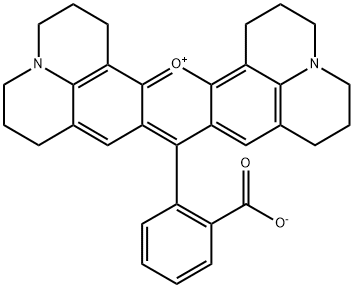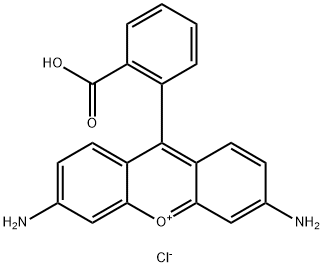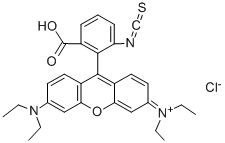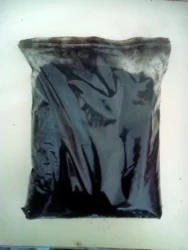Rhodamine B
Synonym(s):Basic Violet 10;Brilliant Pink B;Rhodamine O;Tetraethylrhodamine;Tetraethylrhodamine, Brilliant pink B
- CAS NO.:81-88-9
- Empirical Formula: C28H31ClN2O3
- Molecular Weight: 479.01
- MDL number: MFCD00011931
- EINECS: 201-383-9
- SAFETY DATA SHEET (SDS)
- Update Date: 2025-12-24 14:33:46

What is Rhodamine B?
Description
C.I. Food red 15 is a green crystalline or redviolet powdered solid. Molecular weight =479.1. HazardIdentification (based on NFPA-704 M Rating System):Health 1, Flammability 1, Reactivity 0. Highly soluble inwater.
Chemical properties
red/brown or green crystals
Chemical properties
C.I. Food red 15 is a green crystalline or redviolet powdered solid
The Uses of Rhodamine B
Rhodamine B is used in biological studies for an anti-reactive oxygen species/hepatic fibrosis drug delivery system based on salvianolic acid B loaded mesoporous silica nanoparticles. Dyes and metabolites, Environmental Testing.
The Uses of Rhodamine B
A useful fluorochrome for histology, FRET and mitochondrial probe.
The Uses of Rhodamine B
As a dye, especially for paper; as a reagent for antimony, bismuth, cobalt, niobium, gold, manganese, mercury, molybdenum, tantalum, thallium, tungsten; as biological stain. Provisionally listed for use in drugs and cosmetics.
Definition
ChEBI: An organic chloride salt having N-[9-(2-carboxyphenyl)-6-(diethylamino)-3H-xanthen-3-ylidene]-N-ethylethanaminium as the counterion. An amphoteric dye commonly used as a fluorochrome.
General Description
Green crystals or reddish-violet powder. Used as a dye, especially for paper, as a metal chelating reagent, and in drugs and cosmetics.
Air & Water Reactions
Very soluble in water. Solution is bluish-red. Dilute solutions are strongly fluorescent.
Reactivity Profile
Acidic organic/inorganic salts, such as Rhodamine B, are generally soluble in water. The resulting solutions contain moderate concentrations of hydrogen ions and have pH's of less than 7.0. They react as acids to neutralize bases. These neutralizations generate heat, but less or far less than is generated by neutralization of inorganic acids, inorganic oxoacids, and carboxylic acid. They usually do not react as either oxidizing agents or reducing agents but such behavior is not impossible. Many of these compounds catalyze organic reactions.
Hazard
Questionable carcinogen.
Potential Exposure
It is used as a color additive in drugs, foods, cosmetics, and fabric dyes. It is also used as a tracing agent in water pollution studies. May be used as an agricultural chemical
First aid
If this chemical gets into the eyes, remove anycontact lenses at once and irrigate immediately for at least15 min, occasionally lifting upper and lower lids. Seek medical attention immediately. If this chemical contacts theskin, remove contaminated clothing and wash immediatelywith soap and water. Seek medical attention immediately. If this chemical has been inhaled, remove from exposure,begin rescue breathing (using universal precautions, including resuscitation mask) if breathing has stopped and CPR ifheart action has stopped. Transfer promptly to a medicalfacility. When this chemical has been swallowed, get medical attention. Give large quantities of water and inducevomiting. Do not make an unconscious person vomit.
Storage
Color Code—Blue: Health Hazard/Poison: Storein a secure poison location. Prior to working with C.I. Foodred 15 you should be trained on its proper handling andstorage. Store in tightly closed containers in a cool, wellventilated area away from oxidizers and reducing agents.Where possible, automatically pump liquid from drums orother storage containers to process containers.
Shipping
UN3143 Dyes, solid, toxic, n.o.s. or Dye intermediates, solid, toxic, n.o.s., Hazard Class: 6.1; Labels: 6.1-Poisonous materials, Technical Name Required.
Purification Methods
Major impurities are partially dealkylated compounds not removed by recrystallisation.Purify the dye by chromatography, using ethyl acetate/isopropanol/ammonia (conc)(9:7:4, RF 0.75 on Kieselgel G). It has also been crystallised from a concentrated solution in MeOH by slow addition of dry diethyl ether; or from EtOH containing a drop of conc HCl by slow addition of ten volumes of dry diethyl ether. The solid is washed with ether and air dried. The dried material has also been extracted with *benzene to remove oil-soluble material prior to recrystallisation. Store it in the dark. [Beilstein 18 II 486, 18 III/IV 8246, 19/8 V 669.]
Properties and Applications
|
TEST ITEMS |
SPECIFICATION |
|
APPEARANCE |
GREEN GLITTERY CRYSTAL |
|
SHADE (COMPARE TO STANDARD) |
CLOSE |
|
WATER SOLUBILITY (60°C) |
8 g/L min |
|
WATER INSOLUBLE |
0.5% max |
|
TINTING STRENGTH |
500-505 % |
Incompatibilities
Dust may form explosive mixture with air. Incompatible with oxidizers (chlorates, nitrates, peroxides, permanganates, perchlorates, chlorine, bromine, fluorine, etc.); contact may cause fires or explosions. Keep away from alkaline materials, strong bases, strong acids, oxoacids, epoxides, strong reducing agents
Properties of Rhodamine B
| Melting point: | 210-211 (dec.)(lit.) |
| Density | 0.79 g/mL at 20 °C |
| refractive index | 1.6500 (estimate) |
| Flash point: | 12 °C |
| storage temp. | room temp |
| solubility | H2O: soluble1mg/mL |
| form | Solid |
| Colour Index | 45170 |
| color | Green |
| PH | 3-4 (10g/l, H2O, 20℃) |
| Water Solubility | SOLUBLE |
| Merck | 14,8183 |
| BRN | 4119648 |
| Stability: | Stable. Incompatible with strong oxidizing agents. |
| CAS DataBase Reference | 81-88-9(CAS DataBase Reference) |
| IARC | 3 (Vol. 16, Sup 7) 1987 |
| NIST Chemistry Reference | Rhodamine b(81-88-9) |
| EPA Substance Registry System | Rhodamine B (81-88-9) |
Safety information for Rhodamine B
| Signal word | Danger |
| Pictogram(s) |
 Flame Flammables GHS02  Exclamation Mark Irritant GHS07 |
| GHS Hazard Statements |
H225:Flammable liquids H319:Serious eye damage/eye irritation H336:Specific target organ toxicity,single exposure; Narcotic effects |
| Precautionary Statement Codes |
P210:Keep away from heat/sparks/open flames/hot surfaces. — No smoking. P305+P351+P338:IF IN EYES: Rinse cautiously with water for several minutes. Remove contact lenses, if present and easy to do. Continuerinsing. |
Computed Descriptors for Rhodamine B
Rhodamine B manufacturer
Arnish Laborates Private Limited
New Products
4,4-Difluoropiperidine hydrochloride tert-butyl 9-methoxy-3-azaspiro[5.5]undecane-3-carboxylate Indole Methyl Resin N-Isopropylurea N,N-Dicyclohexylcarbodiimide(DCC) MELDRUMS ACID 5-METHYLISOXAZOLE-4-CARBOXYLIC ACID Magnessium Bis glycinate Zinc ascorbate 1-bromo-2-butyne 2-acetamidophenol 9(10H)-anthracenone Erythrosin B, 4-Piperidinopiperidine 2-((4-morpholinophenylamino) (methylthio) methylene) malononitrile 2,4-dihydroxybenzaldehyde 3-(4-morpholinophenylamino)-5-amino-1H-pyrazole-4-carbonitrile Methyl 2-methylquinoline-6-carboxylate 2,6-dichloro-4-nitropyridine 4-Bromo-2-chlorobenzonitrile 2-(benzylamino)acetic acid hydrochloride 4-(tert-Butoxycarbonylamino)but- 2-ynoic acid 3,4-dihydro-2H-benzo[b][1,4]dioxepine 1-Phenyl-1-cycloprppanecarboxylicacidRelated products of tetrahydrofuran


![2,3,6,7,12,13,16,17-octahydro-9-(trifluoromethyl)-1H,5H,11H,15H-xantheno[2,3,4-ij:5,6,7-i'j']diquinolizin-18-ium perchlorate](https://img.chemicalbook.in/CAS/20180808/GIF/63561-42-2.gif)

![9-Cyano-2,3,6,7,12,13,16,17-octahydro-1H,5H,11H,15H-xantheno[2,3,4-ij:5,6,7-i'j']diquinolizin-18-ium perchlorate](https://img.chemicalbook.in/CAS/20180808/GIF/137993-41-0.gif)



You may like
-
 Rhodamine B (C.I.45170) supplierView Details
Rhodamine B (C.I.45170) supplierView Details
81-88-9 -
 Basic Violet 10 98%View Details
Basic Violet 10 98%View Details -
 Rhodamine B CAS 81-88-9View Details
Rhodamine B CAS 81-88-9View Details
81-88-9 -
 Rhodamine B 95% (HPLC) CAS 81-88-9View Details
Rhodamine B 95% (HPLC) CAS 81-88-9View Details
81-88-9 -
 RHODAMINE B (81-88-9)View Details
RHODAMINE B (81-88-9)View Details
81-88-9 -
 Black RHODAMINE B 80% DYEView Details
Black RHODAMINE B 80% DYEView Details
81-88-9 -
 Faint Green to very dark Green Rhodamine B 540% (Basic Violet 10)View Details
Faint Green to very dark Green Rhodamine B 540% (Basic Violet 10)View Details
81-88-9 -
 Pink Rhodamine B PowderView Details
Pink Rhodamine B PowderView Details
81-88-9
